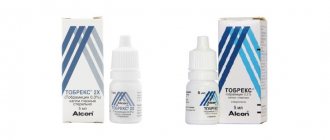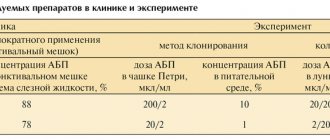Chemical properties
This substance belongs to the group of broad-spectrum aminoglycoside antibiotics The compound is a metabolic product of the actinomycete Streptomyces tenebrarius.
Molecular mass of the substance = 467.5 grams per mole. The product is highly soluble in water, poorly soluble in ethyl alcohol , and almost insoluble in ether and chloroform . In preparations it is most often found in the form of Tobramycin Sulfate , molecular weight of sulfate = 1425 g per mole.
The product is produced in the form of injection solutions of various concentrations; sterile powder for preparing solutions; eye ointment 0.3%; solution for inhalation administration.
Pharmacodynamics and pharmacokinetics
When using low concentrations of the product, it has a bacteriostatic effect, and in high concentrations it a bactericidal .
The substance blocks the normal processes of synthesis of the ribosomal subunit and disrupts the synthesis of white molecules. Further, if the concentration of the drug is high enough, the drug leads to dysfunction of the cytoplasmic membrane , leading to the death of microbes.
Tobramycin affects gram-negative and gram-positive bacteria: Escherichia coli, Proteus (almost all strains), Klebsiella, Serratia spp., Enterobacter aerogenes, Salmonella, Shigella, Providencia spp., Citrobacter spp., Haemophilus aegyptius, Haemophilus influenzae, Moraxella lacunata, Herellea vaginacola , Neisseria gonorrhoeae and some strains of Neisseria spp., Morganella morganii, Acinetobacter calcoaceticus; Enterococcus spp., Staphylococcus (most strains), Streptococcus (beta-hemolytic strains, Streptococcus pneumoniae, non-hemolytic strains).
The antibiotic has also been shown to be more effective in treating diseases caused by bacteria resistant to gentamicin or neomycin . The effect of the substance is more pronounced in the treatment of infections associated with Pseudomonas aeruginosa.
The product is ineffective against various strains of group D streptococcus .
Unlike intramuscular administration, when taken orally the medicine is poorly absorbed by the gastrointestinal tract . The product reaches its maximum concentration after 30 minutes - 1.5 hours.
After a single intramuscular injection at a dosage of 1 mcg per kg of patient weight, an equilibrium concentration of 4 mcg per ml of blood is achieved and maintained for 8 hours. Intravenous administration provides similar concentrations.
The substance almost does not bind to blood plasma proteins and does not accumulate. The compound is found in sputum, abscess , and synovial fluid . The drug does not cross the blood-brain barrier , but penetrates the placenta. Tobramycin is not metabolized. The substance is excreted through the kidneys using glomerular filtration . After 24 hours, only 7% of the drug is present in blood plasma and biological fluids. The half-life is 120 minutes.
In patients with renal impairment and newborns, the pharmacokinetic parameters may be slightly different; the drug can be detected in the body for a longer period of time.
When performing dialysis , depending on the intensity and type of procedure, it is possible to remove from 25 to 70% of the drug.
When used topically as part of eye drops, the substance is not subject to systemic absorption.
Indications for use
The chemical compound is included in solutions for intramuscular and intravenous administration:
- for the treatment of infectious diseases caused by microorganisms sensitive to the action of antibiotics (biliary tract, joints, bones, central nervous system, abdominal cavity, respiratory organs, skin, soft tissues, bile and urinary tract);
- after surgical interventions for the prevention or treatment of various inflammatory processes;
- for sepsis .
Tobramycin for eyes, in drops and gels, is used for bacterial eye infections: blepharitis, keratoconjunctivitis, keratitis, conjunctivitis, blepharoconjunctivitis, iridocyclitis .
Inhalations with Tobramycin are prescribed:
- for the treatment of respiratory tract infections caused by Pseudomonas aeruginosa ;
- children over 6 years old with cystic fibrosis .
Contraindications
The medicine is not prescribed:
- in case of hypersensitivity to this antibiotic or group of aminoglycosides ;
- patients with renal failure;
- with neuritis of the auditory nerve ;
- pregnant women;
- for disorders in the functioning of the brain caused by insufficient function of the 8th pair of cranial nerves .
The drug is used with caution:
- in elderly patients;
- for botulism ;
- in patients with myasthenia gravis or Parkinson's disease ;
- with severe dehydration of the body;
- while breastfeeding.
Special instructions for the use of the drug Tobramycin
Tobramycin should be prescribed with caution to patients with severe impairment of the liver, kidneys, vestibular apparatus, as well as elderly patients with reduced renal function. If surgical intervention is necessary, you must inform the anesthesiologist that the patient is taking tobramycin. If signs of intoxication appear, the dose should be reduced or discontinued. The use of tobramycin during pregnancy is indicated only in cases where the expected effect on the expectant mother exceeds the possible negative effect on the fetus. The safety of tobramycin during breastfeeding has not been established.
Side effects
When used systemically, the following adverse reactions may occur:
- diarrhea , liver problems, increased levels of liver enzymes or bilirubin ;
- vomiting, nausea, polyuria , thirst, oliguria , proteinuria , increased levels of urea and creatinine , frequent or infrequent urination, dizziness;
- proteinuria, disorders of tubular secretion;
- anemia , leukocytosis , thrombocytopenia, leukopenia, granulocytopenia ;
- damage to the vestibular apparatus and hearing, deafness, vertigo , tinnitus;
- headaches, drowsiness, convulsions , disturbances in the orientation of movements;
- paresthesia , hypocalcemia , deficiency of sodium and magnesium in the blood;
- rashes and itching on the skin, hyperemia , fever , eosinophilia , Quincke's edema , other allergic reactions .
After inhalation, the likelihood of developing:
- ulcerative lesions of the oral cavity, fungal infections;
- shortness of breath, bronchospasm , nosebleeds;
- runny nose , voice changes, cough, pharyngitis , laryngitis ;
- sinusitis , hyperventilation , asthma , hypoxia .
When using the product in ophthalmic practice, local reactions occur:
- itching, swelling and redness of the eyelids;
- burning and pain during and after instillation or application of ointment;
- blurred vision.
Tobramycin-Gobbi, 60 mg/ml, solution for inhalation, 5 ml, 56 pcs.
Therapy with the drug should only be carried out under the supervision of a physician experienced in the treatment of cystic fibrosis. The drug should not be diluted or mixed with other medications, including in a nebulizer container. If, after a single inhalation use, an unused solution of the drug remains in the ampoule, it should be disposed of properly. Re-use of unused solution is unacceptable.
Treatment with the drug, alternating courses of therapy with breaks, is carried out until the clinical effect is maintained. Pseudomonas aeruginosa should be considered.
. When using the drug, continue to follow the standard regime of physiotherapeutic procedures. If necessary, treatment with bronchodilators can be continued. Complex therapy is recommended to be carried out in the following order: taking bronchodilators, physiotherapeutic procedures, inhalation of other drugs and, finally, inhalation of tobramycin.
Since the development of bronchospasm has been observed in rare cases after inhalation of tobramycin, the first dose of the drug is inhaled under the supervision of a physician. Prescribed bronchodilator therapy should be carried out before the first inhalation of the drug. Before and after inhalation of tobramycin, it is necessary to determine the function of external respiration - forced expiratory volume (FEV1). If bronchospasm develops in patients not receiving bronchodilator therapy, the determination of FEV1 must be repeated, in some cases with the use of bronchodilators. If bronchospasm is not eliminated after using bronchodilators, then the cause of its development may be increased sensitivity to the drug. If an allergic reaction is suspected, inhaled tobramycin should be discontinued and appropriate bronchodilator therapy should be initiated.
Given the potential nephrotoxicity of aminoglycosides when used parenterally, renal function must be assessed before starting therapy with Tobramycin-Gobbi (despite the inhalation route of administration).
After every 6 full cycles of therapy with Tobramycin-Gobbi, the content of urea and creatinine in the blood plasma is re-determined (1 cycle = 28-day course of treatment + 28-day break).
Considering the potential ototoxicity of aminoglycosides, during treatment with the drug it is necessary to determine hearing acuity in patients with any hearing impairment (tinnitus, decreased hearing acuity), as well as at risk of such complications (especially in the presence of previous long-term systemic therapy with aminoglycosides or with concomitant parenteral therapy with aminoglycoside antibiotics).
In patients who have previously received long-term systemic treatment with aminoglycosides, before prescribing Tobramycin-Gobbi, it is necessary to determine hearing acuity.
If there are signs of nephrotoxicity or ototoxicity, treatment with the drug should be discontinued until the tobramycin plasma level drops below 2 mcg/ml. After this, at the discretion of the doctor, treatment can be resumed. In patients with normal renal function, 1 hour after inhalation of tobramycin, the serum concentration of the drug is approximately 1 mcg/ml.
In patients with impaired hearing and/or renal function, as well as those receiving concomitant parenteral therapy with aminoglycosides, it is necessary to regularly determine the concentration of tobramycin in the blood plasma.
Given the risk of cumulative toxicity, it is necessary to monitor patients receiving concomitant parenteral therapy with other aminoglycoside antibiotics.
Aminoglycosides may have a curare-like effect on neuromuscular transmission and increase muscle weakness.
There is a theoretical risk that patients treated with inhaled tobramycin may develop resistance to Pseudomonas aeruginosa
to intravenous tobramycin.
Impact on the ability to drive vehicles and machinery
There is no data on the effect of the drug on the ability to drive vehicles and operate machinery. Due to the possible occurrence of dizziness or drowsiness, caution should be exercised when driving vehicles or operating machinery.
Tobramycin, instructions for use (Method and dosage)
Depending on the dosage form, disease and age, different treatment regimens and dosages are used.
Intravenous and intramuscular administration
As a rule, the drug is administered by drip, in the form of infusion . injection solution is diluted in an isotonic solution of sodium chloride or glucose . The duration of the procedure is from 20 minutes to an hour.
Before intramuscular administration, the drug is dissolved in a 0.5% procaine solution or in water.
The dosage varies depending on the location of the infection and the type of pathogen.
On average, the daily dosage for an adult is calculated at 2-3 mg per kg of weight. Injections are made 3 times a day.
In severe cases, it is recommended to prescribe 4-5 mg per kg of weight, divided into 4 doses.
For children over 2 months of age, dosage adjustment is necessary. As a rule, from 6 to 7.5 mg of the product are used per kg of the child’s weight. The frequency of administration is the same as for adults.
For children under 2 months of age, it is recommended to administer 4 mg per kg of body weight per day, divided into 2 infusions. The duration of treatment, as for other antibiotics , is from 7 to 10 days.
The drug is also prescribed in the form of inhalations . You must follow your doctor's instructions.
Instructions for Tobramycin eye drops and ointment
For a moderate infection, instill 1-2 drops into the affected eye ( conjunctival sac ), 3-4 times a day, every 4 hours.
If a severe infectious process has developed, then it is recommended to use eye drops every hour - 30 minutes. After the inflammation has reduced, they switch to the normal regimen of taking the drug.
Eye ointment is placed behind the affected eyelid 2-3 times a day. According to indications, the frequency of use of the medicine can be increased to 4 times a day. Then they switch to the normal regimen.
The duration of treatment depends on its effectiveness.
Overdose of the drug Tobramycin, symptoms and treatment
Acute poisoning with tobramycin can develop if the administered daily dose exceeds 5 mg/kg in adults and 7.5 mg/kg in children. Signs of poisoning: auditory and vestibular disorders, neuromuscular blockade up to the development of paralysis of the respiratory muscles (especially in patients with myasthenia gravis and epilepsy), kidney damage. Treatment of poisoning includes the administration of calcium salts for neuromuscular blockade, ensuring effective ventilation of the lungs, and with the development of acute renal failure - hemodialysis.
List of pharmacies where you can buy Tobramycin:
- Moscow
- Saint Petersburg
Interaction
Furosemide and ethacrynic acid , when combined with the substance, lead to increased ototoxicity of the drugs.
The solution for parenteral use should not be mixed in a dropper or syringe with other medications.
When Tobramycin is taken in combination with aminoglycosides, cephalosporins and polypeptide antibiotics, the load on the kidneys increases.
The drug enhances the neurotoxicity of vancomycin .
Tobramycin, when combined with muscle relaxants , in particular tubocurarine , enhances their muscle-relaxing effect.
Drug interactions Tobramycin
With the simultaneous use of tobramycin with nephro- and ototoxic drugs, the severity of its side effects increases. If such combinations are necessary, the concentration of drugs in the blood plasma should be monitored. The specific toxic effects of tobramycin may be increased when taking loop diuretics (furosemide, ethacrynic acid). Inhibition of neuromuscular transmission increases with simultaneous use with neuromuscular blockers, general anesthetics, polymyxin, as well as with massive transfusion. Tobramycin may enhance the inhibition of respiratory center function by narcotic analgesics.
special instructions
If the patient has previously experienced hypersensitivity reactions to a group of aminoglycosides , then there is a high probability of developing allergic reactions to Tobramycin.
Reversible or complete deafness due to treatment with the drug may appear after the end of treatment. During therapy with the drug, it is recommended to monitor the patient’s general condition, kidney function, levels of calcium, creatinine , protein in the urine, sodium and magnesium in the blood plasma, and conduct audiometric tests .
Sometimes dosage adjustment is required in special groups of patients (pregnant women, peritonitis and burns, persons with high cardiac output or glomerular function).
It should be remembered that long-term use of the substance leads to the development of superinfections , most often mycoses .
It is recommended to take a 5-minute break between instilling this product and any other drug in the form of eye drops.
Side effects of the drug Tobramycin
With long-term use of tobramycin in high doses, its nephro- and ototoxic effects may occur; less often - increased levels of serum bilirubin, liver enzyme activity, damage to the optic nerves, inhibition of neuromuscular transmission, changes in hematological tests (anemia, leukopenia, leukocytosis, granulocytopenia, thrombocytopenia), neurotoxic phenomena; Allergic reactions are possible - itching, rash, urticaria, Quincke's edema, anaphylactic shock. When using eye drops, rarely - transient hyperemia of the conjunctiva, a burning or tingling sensation after instillation of the drug; very rarely - hypersensitivity reactions.
Reviews of Tobramycin
Reviews about the use of the antibiotic are good, the drug is quite effective, serious adverse reactions occur infrequently.
Some reviews about the drug:
- “... While playing, my daughter injured her eye and fell on a toy. It turned out that nothing particularly bad had happened; they prescribed eye drops with an antibiotic. After each instillation, the daughter became capricious and cried, apparently stinging from the drops. The medicine is good, it helped, there were no complications, no discharge, no pus”;
- “... Throughout the entire course of treatment with Tobramycin, after the injections I felt a little dizzy and had no appetite. However, these symptoms did not bother me much. The main thing is that I punctured the entire course and was cured”;
- “... I had conjunctivitis . I suffered for a long time and tried to treat it with folk remedies. The doctor prescribed this antibiotic. I was very happy when relief came after the first use. Cured conjunctivitis completely.”


